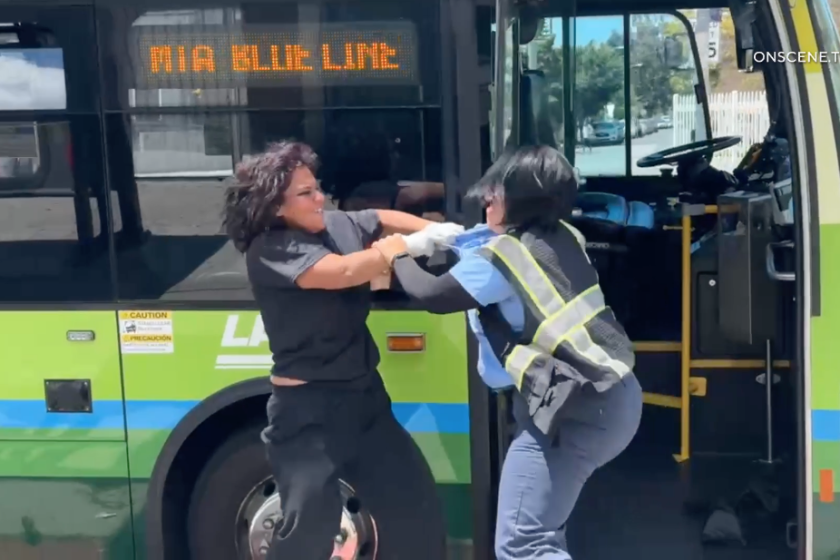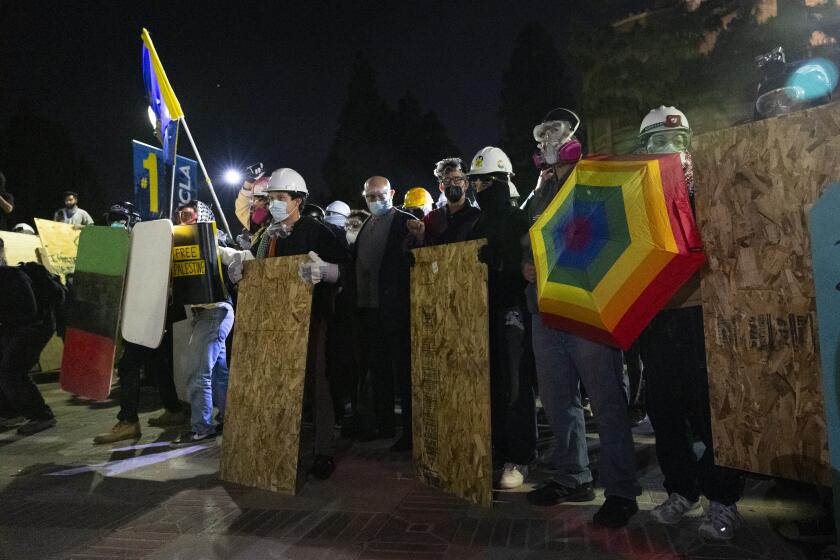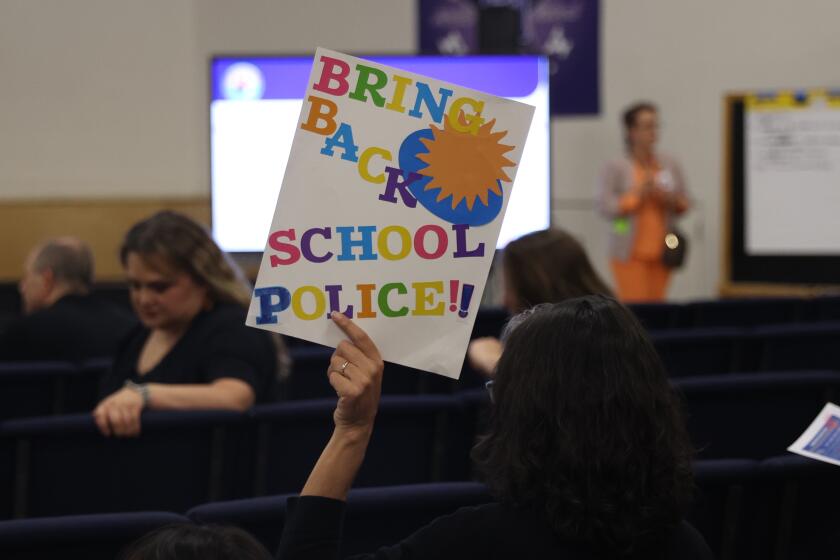O.C. Undercover Probe Nets 17 Tagger Suspects : Graffiti: Officers assumed identities of students and befriended suspected vandals at 2 Anaheim high schools.
Police arrested 17 suspected graffiti vandals during a sweep Friday morning when they concluded a unique undercover investigation in which detectives infiltrated two tagging groups by posing as high school students.
Police said the arrests were part of the largest single sweep targeting taggers in Orange County and the first time investigators went undercover to catch taggers, who spread graffiti in groups called “crews.”
The two undercover officers, who resembled teen-agers, played the part of students and dressed like taggers with donated loose-fitting clothes and closely cropped hair. They befriended the tagging groups and themselves spread graffiti.
Officials said the officers were not allowed to make friends with students not suspected of being graffiti vandals or participate in sports or any after-school activity.
They were required to complete homework assignments and attend classes at Loara and Katella high schools. One officer was assigned to each school.
Officials said the undercover officers, who are in their 20s, did not carry badges, guns or any identification that would have raised suspicions among the high school students.
The officers were introduced as transfer students about nine weeks ago, school officials said.
No one other than the principal of each school and the superintendent of the Anaheim Union High School District knew of the ruse, which was suggested by the Police Department.
“This ruined my streak,” complained one of the youths who was arrested Friday. The 17-year-old, who would not give his name, claimed to have spread graffiti over several Orange County freeways and in several cities.
He said the operation may backfire on police and cause taggers to increase their activity just to spite police and school authorities.
The two undercover officers would not discuss their adventures as students and taggers.
The operation went so smoothly, officials said, that taggers and other students never suspected that the two new students were officers.
Students interviewed outside Katella High on Friday afternoon conceded they did not know police had been working there undercover.
One student, Mike Tadros, a 15-year-old sophomore, said: “I suppose if I was involved in tagging, I would be mad. But I’m not, so I have nothing to hide and nothing to be afraid of.”
Officers arrested five other people during the sweep on unrelated charges, including handgun possession, burglary and narcotics sales, and confiscated at least six weapons, dozens of marking pens and etching devices and a small amount of suspected marijuana.
“The Anaheim Police Department wanted to make a statement” with the sweep, said Lt. Ted Labahn. Tagging “isn’t neat, it isn’t pretty. It is plain and simple vandalism of another’s property,” he said.
Police said the sweep was part of a continuing investigation into widespread tagging in the city. But they acknowledged that they did not know how their message would be received by taggers, who often say part of the thrill comes from evading police.
“Will I expect a dip” in the number of cases, asked Labahn. “Who knows? They might take this as a challenge. We’ll wait and see.”
Unlike gang graffiti vandals, who use markings to show their territory, a tagger’s goal is to gain fame through proliferation.
The tagging phenomenon exploded in Southern California late last year, prompting Orange County officials to engage in an expensive war to try to wipe it out. Cleanup costs countywide are expected to increase from about $1.7 million to about $2.5 million, officials said.
Anaheim police said they have seen the number of tagging crews in the city increase from about five in 1991 to about 100. The city has started a 24-hour graffiti hot line and has established rewards for information leading to the arrest and conviction of people caught tagging.
Recently, the City Council approved a pilot program to hire reserve and retired police officers to conduct stakeouts in neighborhoods.
The school district, which spent about $75,000 to clean up graffiti on its campuses, instructs its teachers on how to recognize tagging and gang clothing, has a liaison with police and has anti-gang classes.
Police declined to say whether they would initiate a similar operation elsewhere.
“Anything is possible now,” said gang investigator Mark Irwin, one of about 55 officers who fanned out early Friday in Anaheim, Fullerton and Yorba Linda to arrest the youths, most of whom attended the two high schools and who range in age from 14 to 18.
Cynthia F. Grennan, the superintendent of the school district, said “I think it would be possible” to have another undercover operation in the school district.
“I think there will be some school districts that will have interest in this” to help combat graffiti on other campuses, she added. She said the school district will consider actions against the students once criminal charges have been decided.
Most of the arrests Friday took place at the teen-agers’ homes. But police made four arrests on campus.
Uniformed officers asked the schools’ principals to get the suspected taggers out of class and take them to the front office, where they were arrested.
The juveniles were taken to Orange County Juvenile Hall in Orange.
Matthew Grider, 18, of Anaheim, arrested on suspicion of possession of a handgun and discharging a weapon into school grounds, was held in Anaheim Jail in lieu of $2,500. Cory Gilleland, 18, of Anaheim, arrested on suspicion of possession of graffiti implements, was cited and released, police said. Juvenile Hall officials declined comment on how long any of the youths might be held.
A juvenile found guilty of misdemeanor vandalism is likely to be sentenced to 20 to 40 days of community service, which often includes cleaning up graffiti, said Randy Payne, a deputy district attorney in the juvenile division. They also face a $250 fine, suspension of their driver’s license and suspension of their search and seizure rights, which opens them up to police searches at any time, Payne said.
Renato Vasquez, 49, the father of a 14-year-old arrested on suspicion of vandalism, said he was happy his son was getting arrested “because this way, he learns his lesson.”
“If he was doing it, he was hiding it from me,” Vasquez said.
Police said they took steps to steer clear of accusations of entrapment because they planned to arrest the same people with whom they were tagging, or in some cases, stealing spray paint.
Officers, after meeting with the district attorney’s office, decided they would not instigate criminal activities. They also received permission from Caltrans and some store owners when they knew in advance about certain vandalism, police said.
“They had to be somewhat involved (in tagging) to get the information they needed,” Grennan said.
Police and high school officials, who were consulted before the start of the investigation, said tagging groups are a threat, not only to property but also to each other because some of them become increasingly violent.
Investigators said they have responded to fights and shootings between groups of taggers.
“You go out and form a tagging group and what happens? You go out into gang neighborhoods and tag,” Irwin said. “Gangs take exception to this. Crews begin to slash each other out as a challenge. There are fistfights, there are shootings. It just escalates.”
Times correspondent Terry Spencer contributed to this report.
More to Read
Start your day right
Sign up for Essential California for news, features and recommendations from the L.A. Times and beyond in your inbox six days a week.
You may occasionally receive promotional content from the Los Angeles Times.






